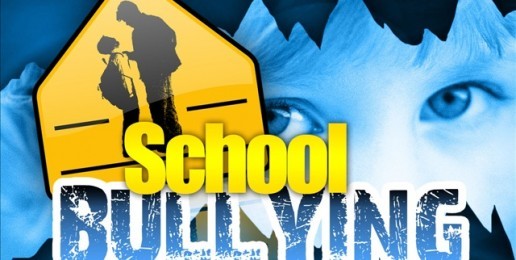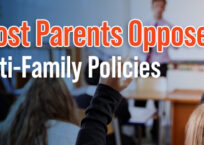
There’s no federal law against bullying or homophobia. So the Department of Education recently decided to invent one. On October 26, it sent a “Dear Colleague” letter to the nation’s school districts arguing that many forms of homophobia and bullying violate federal laws against sexual harassment and discrimination. But those laws only ban discrimination based on sex or race – not sexual orientation, or bullying in general. The letter from the Education Department’s Office for Civil Rights twisted those laws, interpreting them so broadly as to cover not only bullying, but also a vast range of constitutionally protected speech, as well as conduct that the Supreme Court has held does not constitute harassment. In so doing, it menaced academic freedom and student privacy rights, and thumbed its nose at the federal courts.
The letter successfully left the false impression that federal law already bans bullying and anti-gay harassment. For example, a sympathetic news story reported that “the Department of Education issued guidance to all school officials in October 2010, reminding them that federal law requires schools to take action against bullying-including . . . sexual harassment of LGBT students.” The letter was part of a high-profile Obama Administration campaign against bullying, that recently culminated in “a high-visibility conference on bullying prevention March 10, with the president and first lady” and the introduction by Administration allies of “several LGBT-inclusive bills designed to address bullying of students.”
But in reality, there is no federal ban on bullying, and no federal statute prohibiting sexual orientation discrimination. Bills banning anti-gay discrimination, such as the Employment Non-Discrimination Act, have yet to pass Congress. Existing sexual harassment laws generally do not cover harassment aimed at gays based on their sexual orientation, as opposed to their gender – even if such harassment is sexual in nature. As the Supreme Court emphasized in its 1998 Oncale decision, “workplace harassment” is not illegal sexual harassment “merely because the words used have sexual content”; instead, victims “must always prove that the conduct at issue was not merely tinged with offensive sexual connotations, but actually constituted discrimination ‘because of'” a victim’s “sex,” such that “members of one sex are” treated worse than “the other sex.” Thus, federal courts have usually dismissed sexual harassment lawsuits brought by gay employees over bullying and foul language, in cases like Higgins v. New Balance (1999).
Harassment is legally defined even more narrowly in schools than workplaces. In the workplace, harassment need only be severe or pervasive enough to create a hostile environment in order to be illegal. A single, severe physical act can occasionally be enough for a lawsuit.
But in the school context, harassment is defined more narrowly by the Supreme Court’s 1999 Davis decision: it must be “severe” and “pervasive”: to be illegal, sexual harassment must be “so severe, pervasive, and objectively offensive that it can be said to deprive the victims of access to the educational opportunities or benefits provided by the school since “schools are unlike the adult workplace” and “children may regularly interact in a manner that would be unacceptable among adults.” Moreover, the requirement of both severity and pervasiveness means that a lawsuit cannot be based solely on a “single instance” of “severe” peer harassment.
The Education Department’s letter, from Assistant Secretary for Civil Rights Russlynn Ali, flouts the Supreme Court’s harassment definition, claiming that “Harassment does not have to . . . involve repeated incidents” to be actionable, but rather need only be “severe, pervasive, or persistent” enough to detract from a student’s educational benefits or activities. The letter goes out of its way to emphasize that harassment includes speech, such as “graphic and written statements” and on the “Internet.”
The letter falsely implies that anti-gay harassment is generally discrimination based on sex. It cites as an example of illegal “gender-based harassment” a case in which “a gay high school student was called names (including anti-gay slurs and sexual comments) both to his face and on social networking sites.” This is exactly what most federal appeals courts have said does not constitute gender-based harassment. It is not clear whether this case is merely a hypothetical example, or – more disturbingly — a finding by the Education Department’s Office for Civil Rights (OCR) in an actual case. The letter says that “each of these hypothetical examples contains elements taken from actual cases.”
If it actually found a school district guilty of harassment over this, then the Education Department has flagrantly disregarded court rulings, not just about what harassment is, but about how officials are supposed to respond to harassment. In this example of anti-gay harassment, the Education Department says the school district is liable for harassment even though “the school responded to complaints from the student by reprimanding the perpetrators,” which stopped “harassment by those individuals,” because such discipline “did not, however, stop others from undertaking similar harassment of the student.”
That totally contradicts the Supreme Court’s Davis decision, which said school districts are not liable for harassment just because it continues, and are only liable if they are “deliberately indifferent” to harassment once they learn of it; they need not actually succeed in “purging schools of actionable peer harassment” or ensuring that all “students conform their conduct to” rules against harassment.
Even in the workplace, where institutions are liable for mere “negligence” regarding harassment, they are not liable for harassment that continues after steps “reasonably calculated” to prevent harassment – such as when employees stubbornly engage in harassment for which other employees have already been properly disciplined, as a federal appeals court ruled in Adler v. Wal-Mart(1998). Indeed, an institution may sometimes avoid liability even where there was no discipline at all, if it was unclear whether the accused employee was guilty, given due-process concerns.
Essentially, the Education Department has turned harassment law upside down, making schools more liable for harassment than employers, when the Supreme Court intended that they be less subject to liability. (The Education Department letter also suggests racial “sensitivity” training – never mind that this often backfires on institutions. In Fitzgerald v. Mountain States Tel & Tel. Co. (1995), where adverse employee reactions to diversity training spawned a discrimination lawsuit, the appeals court noted that “diversity training sessions generate conflict and emotion” and that “diversity training is perhaps a tyranny of virtue.”)
The letter also implies that it does not matter whether speech is “aimed at a specific target” in considering whether the speech is “harassment.” This stretches harassment law well beyond its existing reach even in the workplace, effectively prohibiting a vast range of speech that a listener overhears and objects to. Employees have tended to lose lawsuits alleging harassment over speech not aimed at them (the California Supreme Court’s 2006 Lyle decision being a classic example), although there are occasional exceptions to this rule. The courts reason that “the impact of such ‘second-hand’ harassment is obviously not as great as harassment directed toward” the complainant herself.
Banning such speech also raises serious First Amendment issues. Recently a federal appeals court cited the First Amendment in dismissing a racial harassment lawsuit by a university’s Hispanic employees against a white professor over his racially-charged anti-immigration messages. In its decision in Rodriguez v. Maricopa County Community College (2010), the court noted that the messages were not “directed at particular individuals” but rather aimed at “the college community” as a whole.
Even if the Education Department were merely trying to impose workplace rules on students, rather than going beyond that, that would still raise serious First Amendment issues. Courts have repeatedly struck down campus harassment codes modeled on workplace “hostile-environment” harassment rules, in cases like Dambrot v. Central Michigan University and DeJohn v. Temple University(2008). As the recent Rodriguez decision noted, “there is no categorical ‘harassment exception’ to the First Amendment’s free speech clause.”
The Education Department also calls on school districts to take “steps to reduce bullying in schools,” saying that “some student misconduct that falls under a school’s anti-bullying policy also may trigger responsibilities under one or more of the federal anti-discrimination laws enforced by the Department’s Office for Civil Rights (OCR).” But if bullying is not motivated by gender or race, it cannot violate federal law. As a federal appeals court put it, “If . . . an employee’s environment, however unpleasant, is not due to her gender, she has not been the victim of” illegal discrimination.
According to the Daily Caller, “the leading advocate for the expanded” definition of harassment contained in the letter “is Kevin Jennings, who heads the Education Department’s Office of Safe and Drug-Free Schools. Jennings founded the Gay Lesbian Straight Education Network advocacy group, and raised at least $100,000 for the Obama campaign in 2008.” GLSEN falsely claims that the letter’s examples of harassment are supported by “current law” and it strongly supports its expansive interpretation of harassment law.
Contradicting the federal courts, the letter says that after harassment occurs, action must be aimed at students in general, not just the individual perpetrators. Following harassment, it says, “The school may need to provide training or other interventions not only for the perpetrators, but also for the larger school community.” Even if the school stops the harassment by disciplining the harassers, the letter claims it may still be liable if it does not take “systemic” and “comprehensive” actions like harassment training for the student body. Moreover, if bullying constitutes sexual harassment, the school may be liable even if it disciplines the bully, if it “failed to recognize” and “acknowledge that the bullying also constituted sexual harassment.
Federal courts have ruled to the contrary. For example, if an employer succeeds in stopping harassment, it will generally avoid liability, even if not all of the harassers – much less employees generally – are sent to harassment training, and even if it takes action under “general” misconduct rules, not a “separate, written” harassment policy. I have never previously encountered the bizarre mandates contained in the Education Department’s letter, even though I handled discrimination cases for years, including time spent working for the Education Department’s Office for Civil Rights.
If the Education Department’s Office for Civil Rights (OCR) succeeds in chilling free speech through its overreaching letter, its officials should be held personally liable for any resulting First Amendment violations. Indeed, it was once held liable for a similar First Amendment violation in Knights of the Ku Klux Klan v. East Baton Rouge Parish School Board (1978). The Ku Klux Klan wanted to meet during non-school hours in an empty classroom, the way other community groups were allowed to do by the school board. But it was prevented from doing so by the school board under pressure from the Office for Civil Rights, which argued that the Klan’s presence would constitute racial discrimination in violation of Title VI of the Civil Rights Act. The Fifth Circuit Court of Appeals held that the school board and OCR had violated the Klan’s First Amendment rights. (Liberal OCR bureaucrats have sometimes wrongly suggested that far less offensive speech than Klan activity can violate Title VI. In 1994, the Education Department’s Judith Winston refused to take a position on whether criticism of affirmative action constituted racial harassment when questioned by Stuart Taylor of the Legal Times, despite the fact that courts have held that criticism of affirmative action policies is not racial harassment, but rather is protected by the First Amendment and the anti-retaliation provisions of federal civil-rights laws).
The Education Department’s letter is a serious threat to free speech and academic freedom, and an egregious display of administrative overreaching that shows disregard for the federal courts and the legal limits on its own jurisdiction.
























